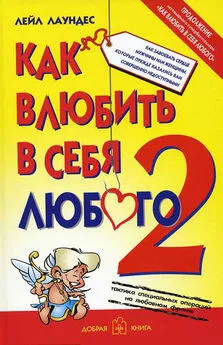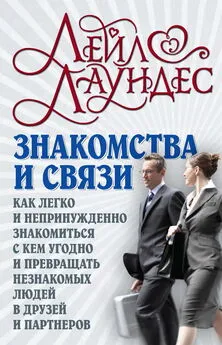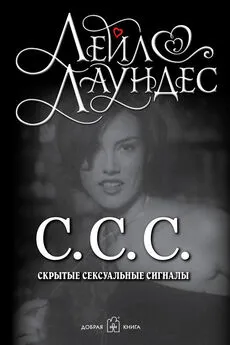Лейл Лаундес - Как влюбить в себя любого – 3. Биохимия любви
- Название:Как влюбить в себя любого – 3. Биохимия любви
- Автор:
- Жанр:
- Издательство:ЛитагентДобрая книгаd7e9a099-70ba-11e4-a4b7-0025905a0812
- Год:2016
- Город:Москва
- ISBN:978-5-98124-646-3
- Рейтинг:
- Избранное:Добавить в избранное
-
Отзывы:
-
Ваша оценка:
Лейл Лаундес - Как влюбить в себя любого – 3. Биохимия любви краткое содержание
Забудьте об Амуре с его стрелами; вот приворотное зелье, которого мы все так долго ждали! Новейшие открытия в области нейробиохимии и когнитивистики перевернули наши представления о природе любви – о том, что воспламеняет ее, что ее убивает, и что делает ее вечной. Формула любви найдена, и она опубликована в этой книге.
В этом новом остроумном практическом руководстве автор легендарного супербестселлера «Как влюбить в себя любого» Лейл Лаундес рассказывает о том, как завоевать сердце мужчины или женщины вашей мечты и сохранить вашу любовь на всю жизнь, опираясь на знание закономерностей развития романтических отношений. Вы узнаете:
[ul]Как новейшие научные исследования нейробиохимической природы любви способны помочь вам строить отношения с другими людьми и управлять ими.
Как привлечь понравившегося вам человека: какими должны быть ваши первые шаги, чтобы отношения стали успешными.
Как произвести неизгладимое впечатление и вскружить голову вашему избраннику (избраннице) на первом же свидании.
Как разжечь пламя страсти: как свести с ума вашего партнера или партнершу в постели.
Как превратить романтическое увлечение в серьезные отношения, а затем и в любовь на всю жизнь.[/ul]
Прочитайте эту книгу, и вы сможете разжечь малейшую искру симпатии во всепоглощающий пожар страсти и поддерживать огонь любви на протяжении всей жизни.
Как влюбить в себя любого – 3. Биохимия любви - читать онлайн бесплатно ознакомительный отрывок
Интервал:
Закладка:
224
Там же.
225
Там же.
226
James T. Winslow, Nick Hastings, C. Sue Carter, Carroll R. Harbaugh, and Thomas R. Insel, «A Role for Central Vasopressin in Pair Bonding in Monogamous Prairie Voles», Letters to Nature , http://research.yerkes. emory.edu/Young/Getz/1993%20Winslow%20N.pdf.
227
Thomas R. Insel, and Lawrence E. Shapiroirie, «Oxytocin Receptor Distribution Reflects Social Organization in Monogamous and Polygamous Voles», Proceedings of the National Academy of Sciences 89, no. 13 (1992): 5981–5985.
228
Phyllis K. Davis, The Power of Touch: The Basis for Survival, Health, Intimacy, and Emotional Well-Being (Carlsbad, CA: Hay House, 1999).
229
Allan Pease and Barbara Pease, The Definitive Book of Body Language (New York: Bantam Books, 2006); James. E. Sheridan, «Marriage Advice: Touch Is a Key to a Truly Good Marriage», News Sentinel , October 25, 2011, http://www.news-sentinel.com/apps/pbcs.dll/ article?AID=/20111025/NEWS01/310269994.
230
Diane Ackerman, «The Brain on Love», New York Times , March 24, 2012, http://opinionator.blogs.nytimes.com/2012/03/24/the-brain-on-love/.
231
Michael W. Kraus, Cassy Huang, and Dacher Keltner, «Tactile Communication, Cooperation, and Performance: An Ethological Study of the NBA», http://socrates.berkeley.edu/~keltner/publications/kraus.huang. keltner.2010.pdf.
232
G. Strong and A. Aron, «The Effect of Shared Participation in Novel and Challenging Activities on Experienced Relationship Quality: Is It Mediated by High Positive Affect?» In Self and Relationships: Connecting In-trapersonal and Interpersonal Processes , edited by Kathleen D. Vohs and Eli J. Finkel, 342–359 (New York: Guilford Press, 2006).
233
Robert R. Provine, «Laughter», American Scientist 84, no. 1 (January– February 1996): 38–47.
234
Rod A. Martin, The Psychology of Humor: An Integrative Approach (Waltham, MA: Elsevier Academic Press, 2006).
235
Elaine Walster and Ellen Berscheid, «Adrenaline Makes the Heart Grow Fonder», Psychology Today , June 1971, 47–62; David M. Buss,
The Dangerous Passion: Why Jealousy Is as Necessary as Love and Sex (New York: Free Press, 2000).
236
Lee T. Gettler, Thomas W. McDade, Alan B. Feranil and Christopher W. Kuzawa, «Longitudinal Evidence That Fatherhood Decreases Testosterone in Human Males», Proceedings of the National Academy of Sciences of the United States of America , http://www.pnas.org/content/early/2011/09/02/1105403108.full.pdf+html.
237
Sandra J. Berg and Katherine E. Wynne-Edwards, «Changes in Testosterone, Cortisol, and Estradiol Levels in Men Becoming Fathers», Mayo Clinic Proceedings 76, no. 6 (2001): 582–592.
238
Helen Fisher, Why We Love: The Nature and Chemistry of Romantic Love (New York: Henry Holt and Company, 2004).
239
G. S. Berns, S. M. McClure, G. Pagnoni, and P. R. Montague, «Predictability Modulates Human Brain Response to Reward», Journal of Neu-roscience 21, no. 8 (April 2001): 2793–2798.
240
Bianca P. Acevedo and Arthur Aron, «Does a Long-Term Relationship Kill Romantic Love?» Review of General Psychology 13, no. 1 (2009): 59–65.
241
Wibke Blaicher, Doris Gruber, Christian Bieglmayer, Alex M. Blaicher, and Wolfgang Knogler, «The Role of Oxytocin in Relation to Female Sexual Arousal», Gynecologic and Obstetric Investigation 47, no. 2 (1999): 125–126.
242
«Ambergris, aka Floating Gold», squidoo, http://www.squidoo.com/ambergrease.
243
Louann Brizendine, The Male Brain (New York: Broadway Books, 2010).
244
Simon LeVay, The Sexual Brain (Cambridge, MA: MIT Press, 1994).
245
M. Kosfeld, M. Heinrichs, P. J. Zak, U. Fischbacher, and others. Fehr, «Oxytocin Increases Trust in Humans», Nature 435, no. 7042 (June 2, 2005): 673–676.
246
Paula Tucker and Arthur Aron, «Passionate Love and Marital Satisfaction at Key Transition Points in the Family Life Cycle», Journal of Social and Clinical Psychology 12, no. 2 (1993): 135–147.
247
Howard, The Owner’s Manual for the Brain .
248
Fisher, Helen, Why We Love .
Интервал:
Закладка:










